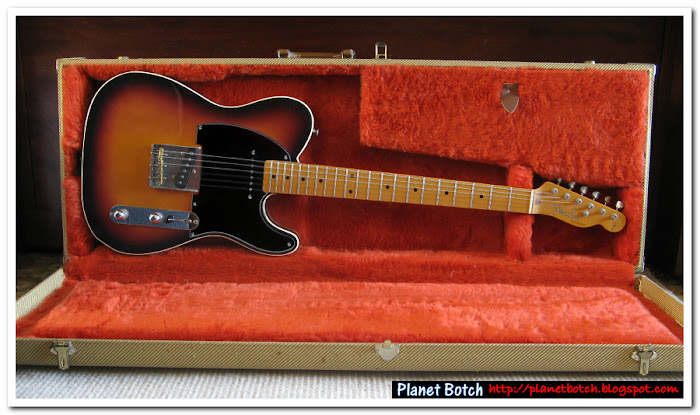
I first saw The Fender ‘Jerry Donahue’ Telecasters advertised in a UK magazine in mid April 1992, so presumably they arrived in the shops some time around the March of that year.
There was an American Fender Custom Shop version with gold hardware, heavily figured maple neck, unbound basswood body with bird’s eye maple veneer front and back, and a “fetch me a chair” price tag of £1,589. And there was a Japanese (MIJ) version, with an edgebound body made from the typical FujiGen Gakki three-piece alder, and a plain-looking maple neck, bearing a suggested retail price of £450. Discount wars being what they were with Fender Japan at the time, that would translate to somewhere between around £350 and £375 in the real world. And it’s this latter guitar I’m going to be looking at in this piece: a good old 1992 Fender MIJ ‘JD’ Telecaster.
At the time, the rather maverick country-orientated guitarist Jerry Donahue was commonly talked about in the guitar magazines for his work with The Hellecasters. But it was the release of his Country Tech instruction video in January 1992 which had really got tongues wagging among the guitar playing community. I myself had been out and bought Country Tech (it’s still lying around the house somewhere in VHS format), and it really was a fascinating insight into a remarkable playing style. What’s more, that tape, and Donahue’s work in general, had respect across the genres. A ‘Jerry Donahue’ Telecaster made sense commercially, because among guitarists, and in particular those who might be interested in a Telecaster, this was a big name artist, in the limelight.
The US Custom Shop version had the full “Jerry Donahue” signature on the headstock, but the MIJ model just said “JD”. So whilst the MIJ was listed in dealer ads and review headings as the Fender Japan ‘Jerry Donahue’ Tele, it was normally referred to as the “JD”. As much as anything else, that was an easy way to differentiate it from the gold-emblazoned USA job. In fact, the MIJ did very well in reviews, which was more than could be said for its Custom Shop sister, whose skyrocket price was always going to give the model a hard time.
Construction-wise, the JD Tele can broadly speaking be considered a custom-shaped 1950s neck on a ’62 reissue body. It’s not an exact ’62 body because the neck pickup required a different cavity, but other than that I’m not aware of any difference. The neck profile was created to Jerry’s spec, with a clear and obvious ‘50s ‘V’. ‘V’ necks are not my favourites, but these weren’t as offensive as some I’ve used, and there really wouldn’t be much point in having a signature model if it wasn’t going to conform to the artist’s prefs. The bridge was also a ‘50s type, with heavy, pre-1954 brass saddles for a good, bright sustain. Headstock hardware was also classic ‘50s fare, as were the knobs and switch cap.
But here’s where things departed from the old pre-CBS traditions… A 3-ply black/white/black scratchplate, fixed with just five screws, and holding in place an alnico Strat pickup, in the neck position. Now things were looking different. And they were sounding different too, because beneath the control plate lurked not a standard Tele selector switch, but a 5-way Strat switch, with a special wiring circuit. They subsequently changed the wiring circuit for these guitars, but this is how the original ’92 version was wired…
- Back Position: bridge pickup (vintage type alnico) for the classic bright MIJ Tele sound.
- ‘In Between’: bridge and neck pickup together with a cap(acitor) ‘n’ phase generated approximation of the Strat ‘in between’ dual pickup tone. It was meant to do the ‘quack’ thing, but to my ears it had a synthetic quality and wasn’t greatly convincing.
- Middle Position: bridge and neck pickup together in standard format.
- ‘In Between’: neck pickup routed through tone control.
- Front Position: neck pickup on tone bypass.
Just to add my customary advice on serial numbers for these instruments. They’re FujiGen Teles with bulk-stamped A0xxxxx vintage bridge plates (often A04xxxx on the early examples, but not necessarily), which means if you try to date them on the Internet you’ll most likely get a 1985/1986 classification. For clarity, this model was definitely not introduced until 1992, so if the Internet tries to tell you you have a 1985/1986 example, don’t get excited – it’s just an error which no one seems to want to correct. You can’t date these vintage bridge MIJ Teles by their serial numbers.
Whatever you thought of the Fender MIJ JD Telecaster as a design, it had that special seal of desirability which FujiGen Gakki routinely instilled into their Fender guitars. The (usually) lightish weight, the high level of personality, zing, zest and responsiveness, the precision build, the pretty aesthetics, and the affordable price. This was another winner from Fender Japan, and with the initials of 1992's Telecaster man of the moment on the headstock, it was assured a kick start on the road to prosperity.
More Telecaster Articles

